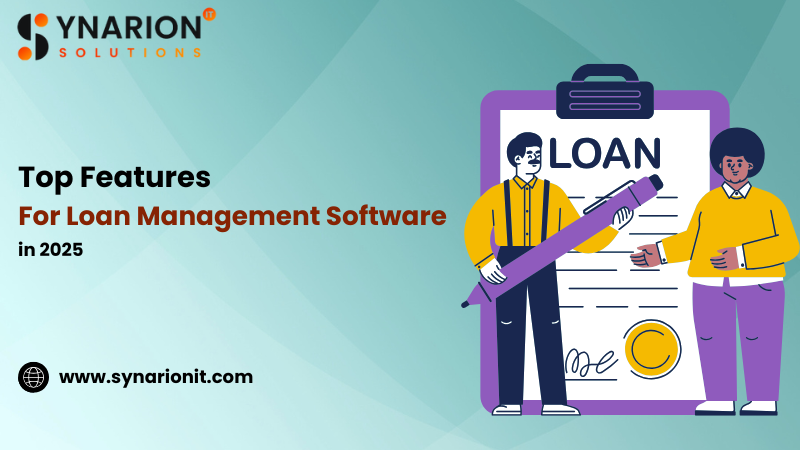Top Features to Look for in a Loan Management Software in 2025
As digital transformation accelerates across the financial sector, loan origination and servicing are becoming more efficient, transparent, and data-driven. With lending institutions—both traditional and alternative—under increasing pressure to offer seamless, automated experiences to customers, the demand for robust and intelligent loan management solutions has never been higher.
In 2025, choosing the right loan management software isn’t just about digital convenience; it’s about staying competitive, improving risk control, and offering scalable solutions that evolve with your business. Whether you’re a bank, NBFC, microfinance company, or fintech startup, investing in the right software—developed by an experienced Loan Management Software Development Company—can significantly improve your operations and compliance.
Here’s a comprehensive guide on the top features to look for in a loan management software in 2025.
1. Automated Loan Origination
In today’s fast-paced lending landscape, manual loan origination is both time-consuming and prone to error. A modern loan management system should streamline this entire process—from application to approval—through automation. This includes:
- Online application forms
- Digital document uploads
- E-KYC integration
- Automated credit scoring using AI
- Instant pre-approval mechanisms
2. Customizable Loan Products
Every lending business is different. Whether you offer personal loans, education loans, mortgages, or payday loans, your software should support the creation of highly customizable loan products. Features should include:
- Adjustable interest rates (fixed or floating)
- Tenure flexibility
- Grace periods
- Multiple repayment modes (EMI, bullet, step-up/step-down)
- Collateral management
3. AI-Powered Risk Assessment and Credit Scoring
The ability to assess borrower risk quickly and accurately is critical. In 2025, expect the best loan management platforms to leverage:
- Alternative credit scoring (social, utility data, transaction history)
- Machine learning models for risk profiling
- Real-time fraud detection
- Behavioral analytics
Advanced Loan Management Software Development integrates these tools, reducing default rates and enabling more informed lending decisions.
4. End-to-End Lifecycle Management
A powerful loan management solution should cover the entire loan lifecycle—from pre-qualification to closure or recovery. Essential stages include:
- Loan origination
- Sanction and disbursement
- EMI scheduling and payment tracking
- Notifications and reminders
- Foreclosure and rescheduling
- Recovery and legal tracking (if required)
Having a single platform that manages the complete cycle boosts operational efficiency and ensures regulatory compliance.
5. Regulatory and Compliance Management
As regulations evolve across countries, maintaining compliance is non-negotiable. Your software should support:
- Central bank reporting formats
- GST and TDS calculations (India-specific)
- KYC and AML compliance
- Automated audit trails
- Integration with regulatory APIs (e.g., CKYC, Aadhaar, PAN, CRILC)
6. Cloud-Native and Mobile-First Architecture
Cloud-based systems offer greater flexibility, uptime, and scalability. In 2025, your loan management software should:
- Be accessible from any device with secure login
- Offer a dedicated mobile app for field agents and customers
- Ensure real-time synchronization across devices
- Support multi-location operations
Cloud-native applications are easier to scale, maintain, and integrate with third-party APIs and services.
7. Multi-Channel Payment Integrations
Loan repayment should be as easy and diverse as possible. Look for:
- UPI, net banking, debit/credit card options
- Auto-debit mandates (eNACH)
- Wallet and QR code integrations
- Offline payment logging options (for field collections)
8. Advanced Reporting and Analytics
Data-driven decisions are the future of lending. Your loan software must provide:
- Real-time dashboards for KPIs
- Detailed reports on NPAs, disbursements, collections
- Risk exposure analytics
- Agent performance tracking
- Portfolio diversification insights
Custom reporting tools also enable lending institutions to stay prepared for audits, investor reviews, and internal assessments.
9. Borrower Self-Service Portal
Modern borrowers expect independence and transparency. A good Loan Management Software Development solution should provide a borrower portal or mobile app for:
- Viewing loan status and repayment history
- Downloading statements
- Making payments
- Raising support tickets
- Receiving real-time notifications
A borrower-facing interface boosts engagement and reduces support center load.
10. Integration with Core Banking and CRM Systems
Loan management doesn’t operate in isolation. Your platform should seamlessly integrate with:
- Core banking systems
- CRM software
- Credit bureaus (CIBIL, Experian, etc.)
- Accounting systems (Tally, QuickBooks)
- Lead management systems
- Notification systems (SMS, email, WhatsApp)
A professional Loan Management Software Development Company will prioritize interoperability and offer secure APIs for hassle-free integration.
11. Role-Based Access and User Permissions
Security and control are crucial in financial services. Your software should support:
- Role-based dashboards
- Restricted access to sensitive data
- Two-factor authentication (2FA)
- Activity logs for all users
- IP-based login restrictions
This helps prevent data leaks, internal fraud, and unauthorized changes to loan records.
12. Scalability and Custom Workflow Engines
As your lending business grows, your software should grow with you. Look for solutions that:
- Handle high transaction volumes without slowing down
- Allow custom workflow configurations (e.g., document flow, approval hierarchy)
- Add new loan types or business segments with minimal effort
- Support multi-branch and multi-language deployment
Final Thoughts
The future of lending is digital, intelligent, and customer-centric. In 2025, a modern loan management system should go beyond the basics—it should act as the backbone of your lending operation, offering unmatched automation, insight, and customer experience.
Whether you’re launching a new lending business or modernizing legacy systems, partnering with a trusted Loan Management Software Development Company is the key to success. The right team can help you implement a powerful, secure, and scalable solution tailored to your needs.


